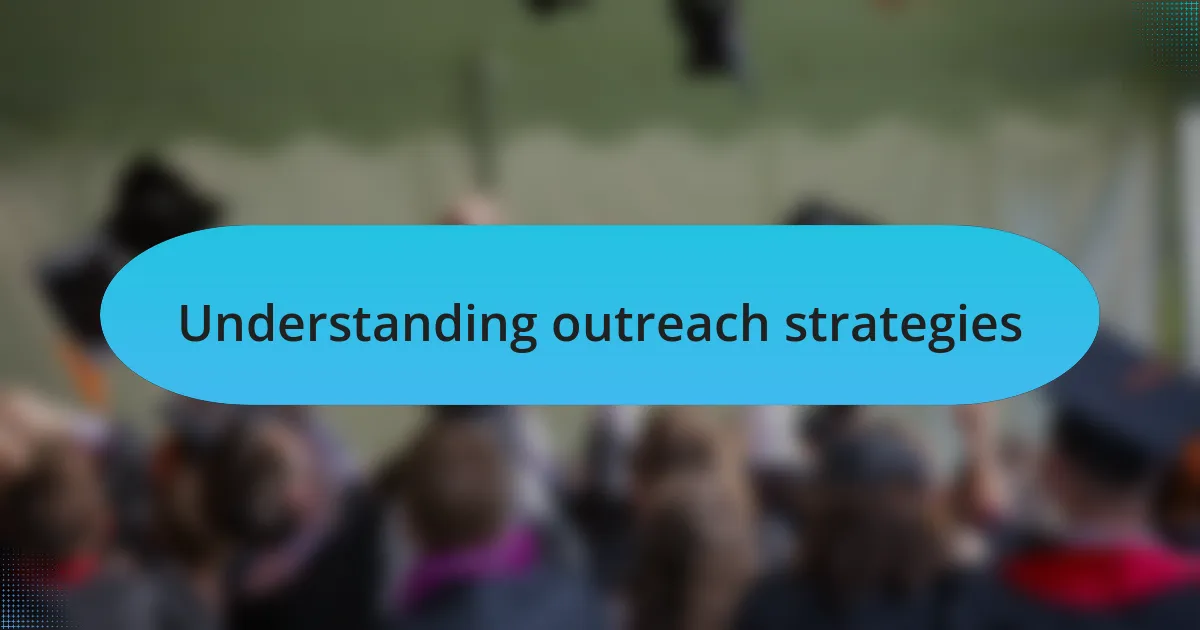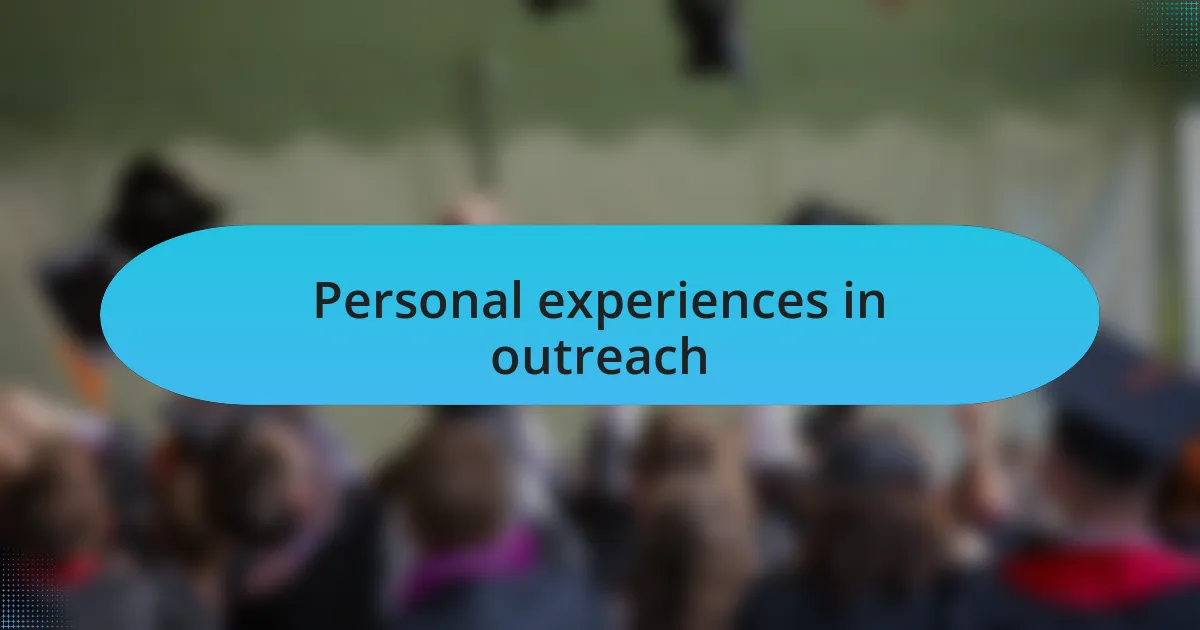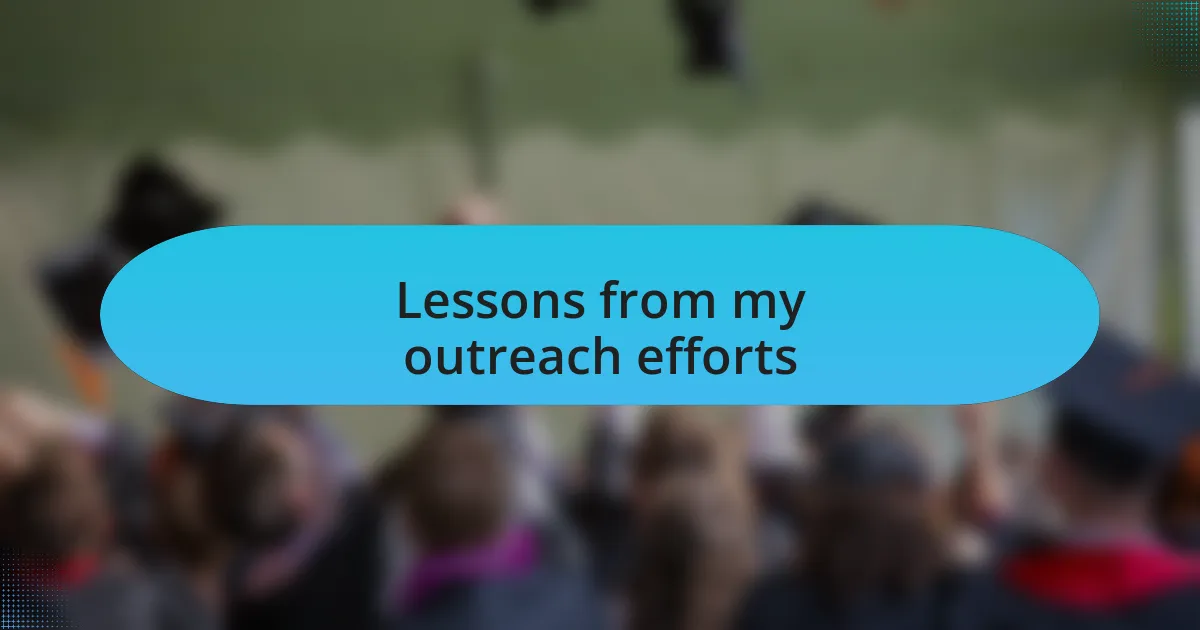Key takeaways:
- Effective outreach strategies require a deep understanding of the audience’s needs, preferences, and emotions to foster genuine connections.
- Authenticity, consistency in communication, and inclusivity are essential components that enhance outreach effectiveness.
- Utilizing technology and analytics tools can streamline outreach efforts and improve responsiveness to audience feedback.
- Building relationships involves active listening, recognizing student achievements, and creating informal opportunities for engagement.

Understanding outreach strategies
Outreach strategies serve as a bridge between organizations and their target audiences, facilitating meaningful connections. I remember when I first engaged in outreach work; I discovered that understanding the unique needs and interests of your audience can transform a basic interaction into a powerful relationship. Have you ever felt like a program or event just missed the mark? That’s often the result of not fully grasping who you’re trying to reach.
Effective outreach isn’t just about broadcasting a message; it’s tailored communication. For instance, I once organized a campus event but realized too late that it clashed with finals week. Reflecting on this misstep, I learned how essential it is to align your strategies with the rhythms and priorities of your audience. How often do we assume we know what the audience wants without asking them directly?
Emotional resonance plays a key role in outreach success. During my time working on student engagement projects, I found that storytelling—sharing real-life experiences—often sparked genuine interest. This made me question: How can we craft narratives that not only inform but also connect on a deeper level? By answering this, I discovered that when outreach resonates emotionally, it encourages active participation and fosters lasting relationships.

Key elements of effective outreach
A key element of effective outreach is authenticity. I remember once attending a workshop where the speaker shared stories from their own campus journey, which struck a chord with all of us. Have you ever listened to someone speak and felt an instant connection? That’s the magic of being genuine—when you share your true experiences, it invites others in and fosters trust.
Another important factor is consistency in communication. During my time coordinating outreach efforts, I found that maintaining a unified message across various channels reinforced our objectives. I often wondered: how can we ensure that our audience receives a cohesive experience? By regularly engaging with students through social media, emails, and in-person interactions, we built a recognizable presence that kept our initiatives front of mind.
Lastly, inclusivity can’t be overlooked in outreach strategies. I recall a time when I encouraged feedback from diverse student groups about our programs. The responses not only highlighted areas for improvement but also opened my eyes to perspectives I hadn’t considered. Isn’t it fascinating how listening to multiple voices can enrich our outreach efforts? By actively inviting different viewpoints, we can create experiences that resonate with a broader audience and foster a sense of belonging within the community.

Tools for successful outreach
When it comes to tools that facilitate successful outreach, technology plays an indispensable role. I vividly remember the first time I used a survey tool to gauge student interest in our activities. The feedback was instantaneous and incredibly enlightening—have you ever seen how numbers and responses can paint a clearer picture than any discussion? Utilizing platforms like Google Forms or SurveyMonkey not only streamlines data collection but also ensures that every voice is heard, allowing you to tailor your outreach more effectively.
Social media management tools also proved invaluable during my outreach projects. I used to juggle multiple accounts, often feeling overwhelmed by notifications. But once I discovered a scheduling tool, I found that planning posts ahead of time allowed me to engage more thoughtfully. It made me wonder how much we miss when we’re too reactive. With this level of foresight, I became more strategic, thus amplifying our message across channels and creating buzz before major events.
Lastly, I can’t stress enough the significance of analytics tools. A few months into a campaign, I dove into the metrics, and it was like uncovering hidden treasures. By analyzing which initiatives resonated most, I was able to pivot quickly and allocate resources where they were needed most. Doesn’t it feel empowering to use data to guide decisions? Analyzing performance not only refined my approach but brought our team closer to our audience—creating outreach efforts that truly hit the mark.

Building relationships with students
Building genuine relationships with students is essential for effective outreach. I recall a moment when I organized an informal coffee chat on campus. The atmosphere was relaxed, and I was surprised at how comfortable students felt opening up about their experiences. It made me realize that sometimes, all it takes is a simple invitation to build trust and connection. Have you ever noticed how sharing a cup of coffee can dissolve barriers?
Engagement goes beyond just planning events; it’s about listening and being present. One time, I set up a student advisory board, which consisted of a diverse group of students from various backgrounds. Their insights were invaluable. They voiced concerns I hadn’t even considered, which deepened my understanding of their needs. It’s striking how empowering it can be to give students a platform where their opinions genuinely matter—don’t you agree that their voices can guide us in meaningful ways?
Additionally, consistency in communication plays a crucial role in relationship building. I made it a point to send out regular updates, not just about upcoming events, but also recognizing student achievements. During one of these newsletters, a student reached out to express gratitude for being highlighted. That simple acknowledgment of their hard work fostered an even stronger connection. When students see that we celebrate their successes, it shows them that we care—not just about participation, but about them as individuals.

Personal experiences in outreach
One outreach strategy that resonated with me was hosting themed discussions in different campus locations. I remember setting up a “Mental Health Matters” conversation outside the student union on a sunny day. The casual setting encouraged many passersby to stop and share their thoughts. It made me realize how vital it is to meet students where they are, both physically and emotionally—do you think location can change the dynamics of discussions?
During outreach efforts, I found that storytelling could bridge gaps between students and the union. I once invited a panel of juniors to share their first-year challenges. Their candid stories drew in a crowd and sparked conversations among attendees who initially felt hesitant to join. I often wonder: why do stories resonate so deeply? Perhaps it’s because they remind us that we all face similar struggles and triumphs.
I also learned that spontaneous outreach moments can leave lasting impressions. A few months ago, I joined a late-night study session at the library, simply to be there for students in a time of stress. As I chatted with them about their coursework, I was struck by their gratitude. I realized that sometimes, just showing up can be one of the most effective outreach tactics. Don’t you think that being present can sometimes speak louder than any planned event?

Lessons from my outreach efforts
I discovered that collaborating with various campus organizations can amplify outreach efforts in unexpected ways. For instance, when I partnered with the environmental club for an “Eco-Friendly Fair,” the turnout exceeded my expectations. Engaging with diverse groups not only broadened our reach but also fostered vibrant discussions about sustainability—what better way to encourage change than by blending passions?
Another lesson was the importance of follow-up. After hosting an event, I started reaching out to attendees for feedback. One time, I sent a simple survey after a workshop on academic resources, and the responses were eye-opening. Students appreciated the resources, but many expressed a desire for more hands-on tutorials. This interaction helped me shift future workshops to be more interactive—have you ever realized how powerful feedback can be in shaping future initiatives?
Lastly, I learned that empathy is a game-changer in outreach. One day, while volunteering at a stress-relief event, I met a freshman who felt lost and overwhelmed. Listening to her fears and offering guidance made a significant difference. It struck me that truly connecting with students can turn an ordinary outreach effort into a supportive experience—how often do we forget that a little empathy can go a long way?